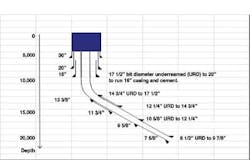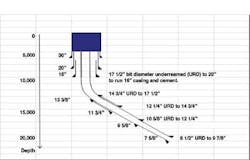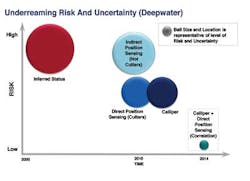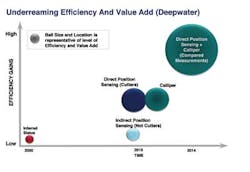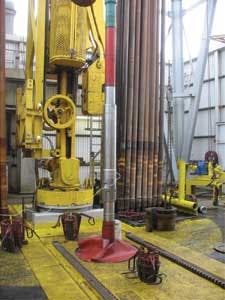Closed loop underreaming improves deepwater drilling
Wajid Rasheed
Jaime Bernardini
John Thorogood
Smart Wellbore Systems
Drilling a gauge hole is a basic requirement of wellbore construction, but it is not easy to deliver. To ensure a gauge hole and improve well construction, a novel wellbore diameter and underreaming control system has been developed.
The patented closed loop underreaming system's comparative measurements provide new insight into downhole conditions by measuring wellbore diameter and tracking the downhole status of the underreamer (reamer). This gives the operator a clear understanding of hole gauge and issues impacting gauge. The system also allows underreamer or reamer performance to be monitored and remedied in situations where the cutters may be extended but the calliper shows undergauge hole, indicating a radially shrinking formation with time or cutter wear. Ultimately, this data can be used to improve casing running and keep cementing tolerances within specification.
The closed loop underreaming system monitors the extension and retraction positions of the cutter block, and a telemetry system communicates caliper data and control signals between downhole tools and a surface interface. Dimension data prompt tests and checks on effective deployment of the cutters across a section or a trouble zone subject to radial shrinkage or hard stringers. This can trigger a repeated cycle of expansion, prompting the operator to intervene and activate or deactivate cutters in response to the caliper. The system can control cutter block extension in response to caliper measurements, which can be applied to activate a near bit-reamer after satisfactorily underreaming the section. This ensures the rat-hole is enlarged only when the section is at the pre-determined hole size or any remedial work has been completed. The user can program the system to meet well-specific scenarios such as deactivating a first reamer and then activating the second, which can be either near-bit or string. In addition, a secondary redundant reamer can be activated based on wellbore measurements to save a trip to replace a worn underreamer.
The complex, dynamic interplay between the formation, bit and drillstring during standard drilling operations is heightened when drilling in deepwater basins exceeding 6,000 ft (1,830 m) water depth, or where the reservoirs underlie massive salt sections.
Running casing is a decision that should be taken in conjunction with wellbore diameter measurements. Although casing can be run to bottom with a casing shoe or a reamer shoe, this does not ensure gauge hole. There is still uncertainty as to whether the "cased" section has the required cementing tolerance. If the actual hole diameter does not match the planned diameter, casing and cementing tolerances will not be achieved. In this event, the entire cycle of underreaming may need to be repeated or an out-of-specification cement job may result.
In general, underreamer activation depends on flow or pressure to extend cutter blocks. Activation occurs only after the underreamer passes through the casing and the casing shoe is drilled out. Avoiding activation inside casing is understandable, but this precludes surface testing to determine whether the underreamer is functional. Further variations in downhole conditions that influence underreamer functionality are hydraulics, bending moments, formation hardness, directional control, and synchronization with the bit.
The "underreaming risk and uncertainty" chart illustrates the relationship between risk/uncertainty in deepwater underreaming and a timeline from the year 2000. Significant sensing innovation occurred circa 2010 when new underreamer measurements were progressively introduced. Risk and uncertainty are highest when no measurements are taken and underreaming is inferred. Often, activation is inferred based on fluid pathways opening in the underreamer and a pressure differential seen at the rig floor. However, inferred underreaming provides mechanical or hydraulic information on the reamer which may or may not correspond with cutter position or the desired well diameter. Other inferred indicators of cutter block position include increased drilling torque when cutters interact with the formation, or pulling up the drillstring and underreamer to the previous hole size in order to see whether the top-drive stalls.
Wellbore measurements, if taken, are a separate activity performed after underreaming. The time-lag between enlargement and measurement leads to risk, uncertainty and unnecessary cost with corrective runs to attain the desired wellbore diameter.
The system provides novel wellbore diameter measurements by means of modular subs around 9 ft (3 m) long which are run typically with a drill collar or pony above the underreamer. The underreamer can also be configured as a string underreamer or a near-bit underreamer, or both, and provided with a stabilizer that can be expandable or fixed. Flexible BHA placement allows the modular subs to be placed either directly above the drill bit or a bull nose, or above a directional control system such as a rotary steerable system. The complete BHA can be modeled and optimized to meet ROP and drilling dynamics requirements.
The modular sub body allows for a through passage and full flow of drilling fluid from the drillstring and drop ball capability. This enables measurement of wellbore diameter accuracy above an underreamer and automatic detection of undergauge hole.
Caliper measurements of the actual diameter of the underreamed hole can partly reduce underreaming risk. They are a first step to achieving the pre-determined diameters required for close tolerance casing, and they also partly enable closed loop control of underreamers to deliver pre-determined wellbore diameters. However further action is necessary to reduce risk and uncertainty, namely tracking the reamer and providing actual underreamer status measurements.
Reamer measurements involve position sensing of moveable components within the tool and can be done indirectly or directly. Indirect sensing occurs when the position of a secondary component such as a sleeve or mandrel is sensed but the position of the cutter block itself is not. Direct sensing occurs when the position of the cutter block is measured as an outward extension corresponding to a pre-determined underreamer size. Direct sensing is advantageous as it positively determines the position of cutters, leading to increased efficiency. The system uses a magnetic direct sensing module which determines the displacement of the reamer cutter blocks. This can be fitted to any expandable reamer to track reamer positions.
Indirect position sensing, in contrast, provides no significant advantage over inferred underreaming and leads to low efficiency gains. Even with direct position sensing only a medium-sized gain in efficiency results. This is because wellbore diameter is not solely a function of the status of underreamer cutter position. Cutters could be worn or lost, or the formation could creep into the hole. Cutter position measurements alone cannot distinguish among these three conditions.
Efficiency gains
For deepwater and subsalt wells the highest efficiency gains arise with direct position sensing and calliper measurements. The chart highlights the increased efficiency that results from comparing and correlating calliper measurements of wellbore diameter with measurements of cutter block positions. Comparative measurements offer solutions to a broad set of operational problems that cannot be solved otherwise. Firstly, wellbore diameter measurements provide a map of radial creep, swelling, rubble zones, or wash outs. Second, position sensors measure the actual underreamer cutter extension. The comparison process offers deepwater drilling engineers a reliable method of achieving good hole quality and eliminating uncertainty.
Correlated measurements also ensure gauge hole is delivered. The drilling engineer can achieve the drilling program objectives more easily by being able to compare the calliper data with direct position sensing in order to confirm whether the cutter blocks are fully extended, partially retracted, or missing completely.
Comparative measurements provide new insight into downhole conditions and can be configured to meet the user's well objectives. Software can be programmed to cross-check the cutter block positional data from magnetic sensors placed on the cutter housing, which can be retrofitted to existing reamers. This shows whether the block has actually been extended. If the block has extended yet the calliper data shows that the actual wellbore is below the planned wellbore size, the user can be alerted by means of mud pulse telemetry or wired pipe to take diagnostic action. Operational parameters can be modified or secondary reamers can be activated to save a trip.
